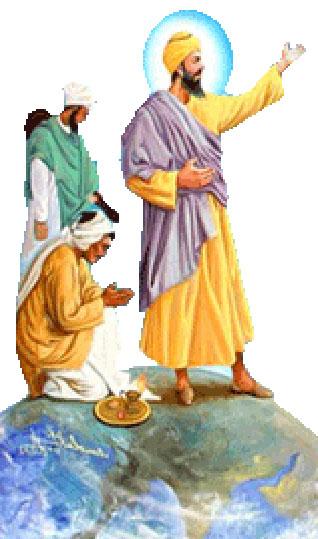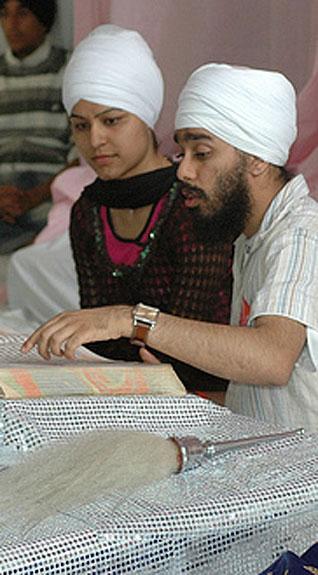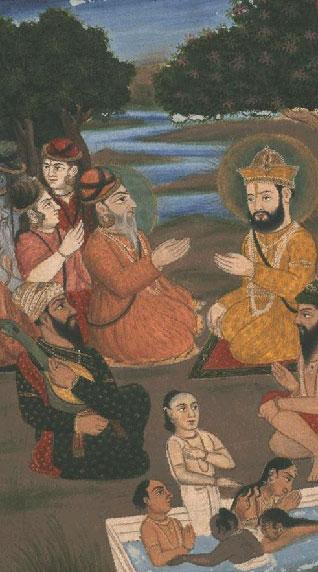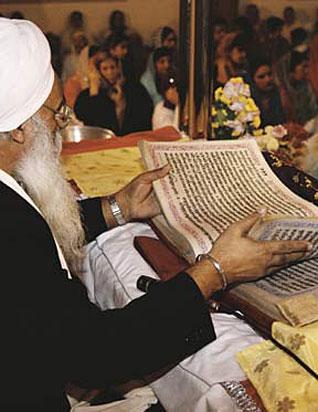
Above - from painting by Amolak Singh. Below, second from bottom - Guru Nanak, in a dialogue with the Sidhs.



Books
The Enquiring Guru
A Book Review by MANJYOT KAUR
THE ENQUIRING GURU: QUESTIONS BY THE SIKH GURUS AND THEIR ANSWERS, by Gurpal Singh Bhuller. The Information Institute, Washington, D.C., 2006. ISBN 0-9772107-1-5. 164 pages. Price: $7.00.
The Enquiring Guru is a thoughtful and incisive compendium of 130 questions and answers about nothing less than life and its meaning, painstakingly parsed out of the Sikh scriptures, Guru Granth.
While the living, eternal Guru of the Sikhs certainly could never be pared down to a mere 130 questions and answers, this short but pithy book is a most useful catechism of the Sikh faith, as well as a springboard for delving into the inexhaustible treasure-chest of Guru Granth. It serves up quite a mouthwatering taste of the unique richness that is Gurbani, making many of its basic, recurring key words and concepts more understandable and accessible.
An articulate, thought-provoking Foreword by I.J. Singh firmly situates this work within the perspective of Sikh tradition.
It highlights the amazingly modern method of horizontal dialogue used by Guru Nanak and his successors, "where not only is there information transfer, but the teacher-pupil interaction serves to generate ideas and wisdom". The pre-eminent role given by the Gurus to dialogue, discussion and debate is indeed "absolutely mind-blowing", when one considers the predilection for vertical dialogue that was, and remains, a major feature of Indian society.
Unlike some other works which seek to clarify and expound upon the teachings of Guru Granth, this book is non-intimidating, user-friendly and highly browsable. At least one answer is provided for each of the 130 questions. The original text is given in Gurmukhi script, accompanied by a smooth and cogent English translation. Notations on authorship and the exact location of the citation in Guru Granth place the quote in context, and motivate the reader to further exploration.
This book is enriched by 140 footnotes. They serve to not only explain the quotes, but provide insights into the depth of meaning of a particular word or phrase, as well as fascinating glimpses into Indian culture during the times of the Gurus. For example, the footnote to the phrase translated as "The Shabad is the Guru" gives a reference to the key concepts of God as reflected in the Mool Mantar, along with the idea that the Divine can be experienced through the Word.
Another note, referring to the "soul bride" who is still in the world of her father's home (i.e., a person who remains attached to material attraction), enlightens the reader about age-old marriage customs.
The types of questions and answers that form this book give one an eyeful of the sublime facets of the incomparable jewel that is Guru Granth. Some of them appear deceptively simple and mundane, flashing only the merest hint of the layers of complex thought that shimmer invitingly beneath the surface.
An example of this is a famous quote by Bhagat Ravidas, a "low-caste" cobbler, used along with an excellent footnote, where he parses "the difference between me and You":
"You are me and I am You -- what is the difference between us? We are like gold and the golden bracelet, or like water and the waves".
Other citations tantalize readers with the stunning poetic imagery that thoroughly permeates the sacred text. For instance, in examining the concept of self-control, Guru Nanak asks: "How can one live in the palace, the home of snow, wearing robes of fire?"
All the quotes, questions and accompanying notes propel the reader along the lifelong path of exploration of the infinitely rich Sikh tradition. As I.J. Singh acknowledges in his Foreword, "Sikhism asks every Sikh to delve personally into its magic and mystery".
This prolonged and repeated reflection, or vichaar, is what Sikhi, which is often called "a religion of laypeople", is truly all about. Indeed, the author of this compilation, Gurpal Singh Bhuller, is not a formally-trained Sikh scholar or theologian, but rather a dedicated lay follower of the faith. He succeeds in inspiring the reader to join him on the quest all sincere spiritual seekers must make: the one of introspection that leads to self-awareness and a truly examined life.
More discursive commentary might have substantially enhanced this work. However, its concise Q&A format necessarily precludes such elaboration. In recompense, the footnotes do go a very long way to enlighten the reader and serve as a stimulus to further thought and discussion.
A somewhat more pressing need is the one for better proofreading and editing. There are some glitches in the text, such as missing footnote numbers and typographical errors. Furthermore, while the List of Headings at the beginning of the book appears in both English and Punjabi versions, the Index of Questions at the back is not translated into English, which would have been a very helpful addition for many readers.
However, these caveats do not detract from what is quite an appealing and useful guide to the ethical framework for productive daily living given to us by Guru Granth. The Enquiring Guru is indeed a most inspiring effort, at once appetizing and satisfying, which definitely deserves a place on the bookshelves of those looking for a valuable compass to help plot their own unique roadmap to an exhilarating inner journey of exploration and discovery.
[This book may be ordered directly from its author. He can be contacted at: GurpalB@aol.com.]
May 31, 2008
Conversation about this article
1: Kanwarjeet Singh (U.S.A.), June 01, 2008, 9:32 AM.
It is good to know how the world is being educated about Sikhi but we've got to be more careful of what we portray - and I am not talking about the book per se, rather about the photograph depicted here showing Guru Nanak Devji with a tilak and a "cap". I have also seen other images where Guru Nanak is shown feeding the Sadhus - which is entirely incorrect. Let us be careful in potraying about our young and bold religion - this message is carried to our young as images are the most powerful tool of education.


